Latest News
Kitchen Chat and more…
Kitchen Chat and more…
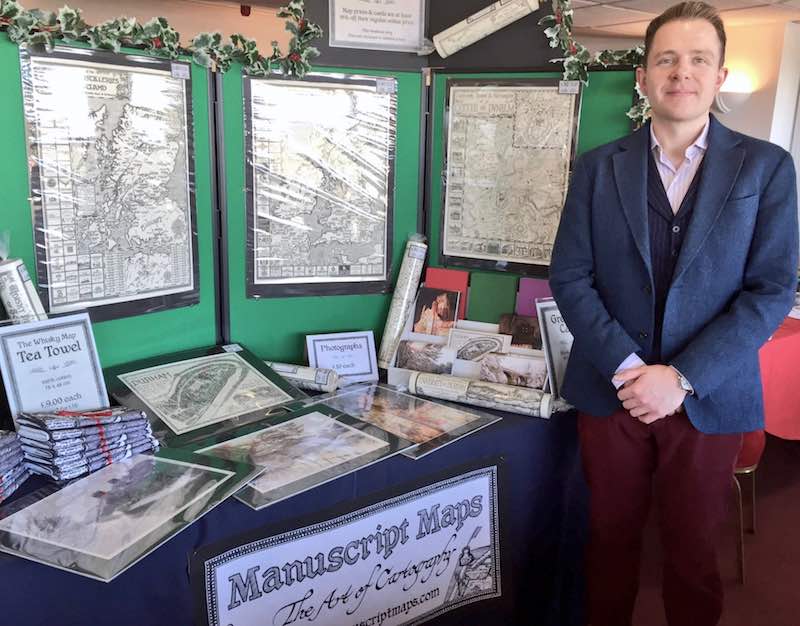
Picture Credits: www.manuscriptmaps.com
Do you like ancient maps? The kind of maps that wow you from the first moment because they were hand-drawn with beautiful details. If you do, you should check out Manuscript Maps.
Manuscript Maps belongs to Mr Kevin Sheehan, a British cartographer who drew all his maps by hand. If you are wondering why WhiskyGeeks is talking about maps, that’s because Kevin has drawn impressive maps of Scotland’s whisky distilleries!
Here’s a picture of one of his latest version:
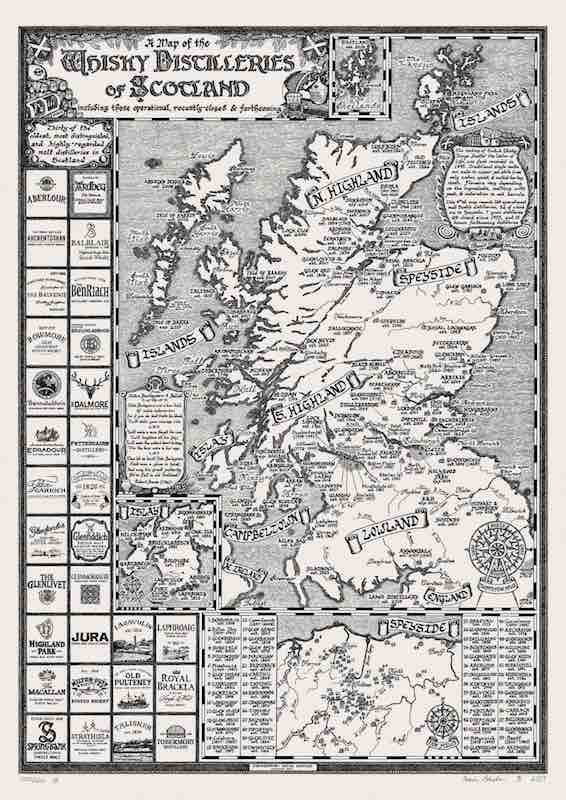
Picture Credits: www.manuscriptmaps.com
Did you marvel at the details on the map? Well, the physical one is even more impressive! Geek Choc bought the whisky map from Kevin, and he was stunned by the beauty of it. “It is amazing just how Kevin can include such minute details like tiny lines to create the shading of the sea. I’ve never seen such excellent artistry!” Geek Choc exclaimed at our headquarters when the map arrived! Well, he was too excited to say anything else after that.
So, as a team, we decided to reach out to Kevin and asked him for an exclusive interview with us, and he agreed to do so. We conducted our conversation through a couple of emails and Kevin kindly provided us with some excellent photos too!

Picture Credits: www.manuscriptmaps.com
Kevin spoke about the history of the whisky map in our first interview with him. His first whisky map was hand-drawn in late-2014. Kevin began with a detailed plan, before drawing the distilleries in pencil and then go over each line with dip pens and ink with different calligraphic nibs. Just as Geek Choc has noticed, every tiny line is hand-drawn, even the shading of the sea. The whisky map took more than 120 hours to draw (that works out to about three months). Kevin also took time to research and communication with the distilleries in Scotland to feature them on his whisky map.
Kevin has printed three editions of his whisky map so far. Each version has been popular, and in fact, the whisky map is his bestseller! He prints each map on 200-300 gsm textured paper, and he numbered, signed and dated every single one of them. The maps at A2 sized, so it is easy to hang them up at home.
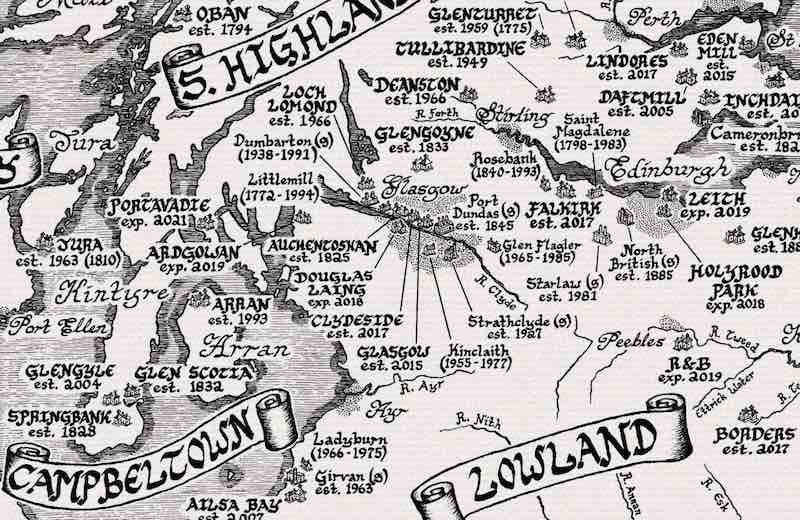
Picture Credits: www.manuscriptmaps.com
The 2017 edition shows 124 operational single malt distilleries, seven grains distilleries, 25 closed distilleries (since the 1970s) and 11 forth-coming distilleries. The 2017 edition has sold out now, and Kevin has released a new 2018 version of the whisky map. This new version is exciting as he included the brand-new Douglas Laing distillery in Glasgow, as well as the planned reopening of Brora, Port Ellen and Rosebank distilleries.
Kevin has an impressive education in the art of map-making. His passion for maps started at childhood, where he drew fantasy Tolkien-style maps. His love for maps led him to do many art classes in his youth and began his journey in the art of map-making. As an undergraduate in Durham, Kevin started to draw maps of the area as gifts for his family and friends. He also took his Master degree in Medieval and Renaissance History and took a class with Mr Paul Harvey, the world expert in medieval mappaemudi. He was so enthralled by the art of map-making by then and pursued his passion with a PhD in the history of cartography.
During his days as a PhD student, the university hired Kevin to draw maps of Durham University and Durham Pub. They sold the prints in the new visitor centre at the school. As you can guess, the maps were a huge hit with visitors. Kevin graduated in 2014 and founded Manuscript Maps. He never looks back since.
Kevin is a whisky lover just like the rest of us. That explains why his first ever map drawn for his company is the whisky map! He loves his Scotch and Irish whiskies, as well as Japanese whiskies. He shared that he like lightly peated whiskies that are well-balanced, so his choices tend to lean towards Speyside and some of the Islay whiskies. Kevin’s favourite distilleries (so far) are Bruichladdich, Bunnahabhain, Lagavulin, Aberlour and Fettercairn. Nonetheless, Kevin’s love for whisky usually leads him to buy whatever is on sale!
Kevin is experimenting with new products for his whisky map. He has printed the map on tea towels and is planning to release a jigsaw puzzle of the map by the end of November!
If you like the whisky map, there is the chance that you will love the gin map that Kevin has drawn as well. It is his second love, after the whisky map. Illustrated in the same dimension and style, it is a perfect complement to the whisky map!
If you are keen to buy the whisky map (or the gin map), you can visit Manuscript Maps right here. He ships internationally so you don’t have to worry that you can’t buy this beautiful map.
You can find Kevin on these social media platforms too:
Twitter: @ManuscriptMaps
Instagram: @ManuscriptMaps
Facebook: www.facebook.com/manuscriptmaps
If you are keen to purchase the maps, do remember to enter the code “WHISKYGEEKS” during check out so that you get 20% off any map you buy! Caring is sharing! Do tell all your whisky friends and head over to www.manuscriptmaps.com.
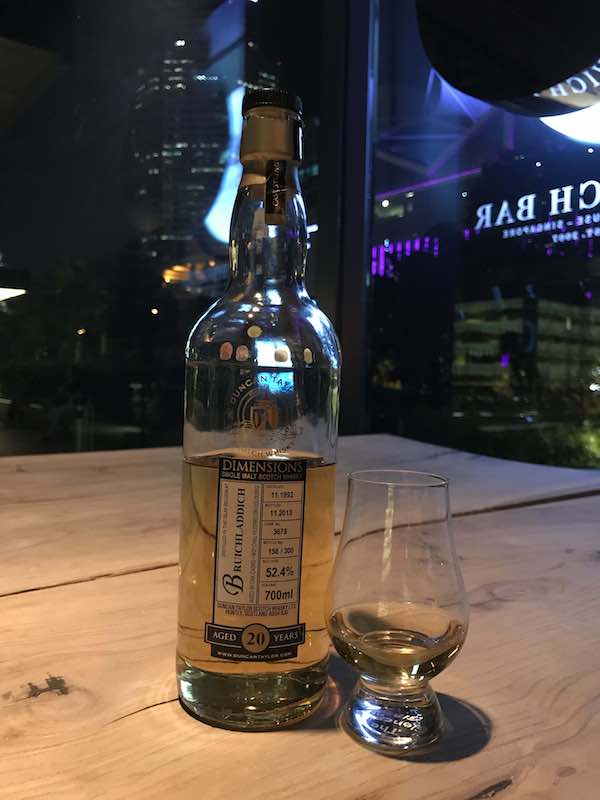
Bruichladdich fans will agree that it usually taste of sweet vanilla notes and is spicy on the palate. However, have you thought about a Bruichladdich that has almost no spice, and instead, takes on a light, grassy note? No? Well, neither have we! Until now…that is.
The subject of this review is a Bruichladdich 20-year-old by the independent bottler, Duncan Taylor. Distilled in 1992, the liquid matured in oak casks for 20 years before getting bottled in 2013. The total yield is 300 bottles.
Let’s look into this excellent dram now.
Colour: Pale Gold
ABV: 52.4%
Nose: Grassy to the max! It smells like an early morning stroll in a meadow, where flowers are just starting to bloom. The sweetness is minimum, but instead, floral notes are prominent. Peppery spice floats in the background, but it is not strong. Un-typical Bruichladdich! After airing for near 30 minutes, the sweetness of white peaches can be detected in the background, making it more typical Bruichladdich. (17/20)
Palate: The taste is light grass and floral all at the same time. Slightly acidic with light peppery spice. Unlike the Classic Laddie, this whisky has almost no spice. After a while, honeyed notes surface and push the spice further into the background. After airing for near 30 minutes, the palate changes completely. The grassy notes are gone and are replaced by sweet white peaches, making the taste more like a typical Bruichladdich. (18/20)
Finish: The finish is short with some sweetness. It does not change with time. (15/20)
Body: It is a simple whisky, but well-balanced. Mind-blown at first but slowly, it develops typical characteristics of Bruichladdich. This is a shot of whisky that can be savoured over an extended period just to see it blossom into its full Bruichladdich character. (32/40)
Total Score: 82/100
Geek Choc: “I did not expect a surprise when I ordered this dram, but boy, did it surprise me with its difference from the typical Bruichladdich. I like the grassy notes and the fact that the spice is minimum. It is nice to taste something different now and then! It is probably a good idea to drink this again in a month’s time to see if the oxidation in the bottle makes this “more Bruichladdich” than what I had.”
Geek Flora: “When Choc told me that this is grassy, I thought he was drunk! Nonetheless, I was impressed when I nosed and tasted this dram. That is fantastic! Well, it is a pity that Spice did not get to try this one because he was overseas. We will drag him along if we try this again!”

Whisky drinkers who are willing to explore outside of Scotland often find themselves on the shores of Australia and Japan to sample renowned world whiskies. We seldom see these whisky hunters landing in South Africa to look for the same things. Not many people know about James Sedgwick Distillery in Wellington, S.A – the home to Three Ships and Bain’s Cape Mountain Grain Whisky.
It is interesting to note that James Sedgwick Distillery is the only commercial distillery in South Africa and their products have won awards after awards in the international scene. The only unfortunate thing for many whisky drinkers in Southeast Asia is the fact that James Sedgwick distillery is selective in their distribution channels due to their limited stocks.
We are lucky in Singapore; our first whisky bar – Quaich Bar – has forged a close relationship with Distell, the company managing James Sedgwick distillery. Therefore, we are one of the first South-East Asian countries to get our hands on their exceptional whiskies.
Before we dive too far off the topic, let us go back to the distillery and explore the origins of this 131-year-old distillery.
James Sedgwick, a former sea captain, founded a company called the J. Sedgwick & Co. which dealt with liquor, cigar and tobacco in 1850. After his death in 1870, two of his sons, Charles and Alfred, took over and expanded the business. They founded JSD in 1886 at Wellington, S.A. and named the distillery after their father. The distillery sat on the banks of the River Berg but did not begin its life as a whisky distillery until much later.
JSD started its life as a commercial whisky distillery in 1990 when they relocated the production of Three Ships to JSD. The move also coincided with the appointment of the 6th distillery manager – Andy Watts. Andy learned the art of whisky-making in Scotland and had perfected his skills for many years before coming to work with JSD. His skills, experience and knowledge have contributed to the success of JSD.
The last 26 years see significant innovation and improvement of the distillery. In an attempt to ensure that the distillery is environmentally friendly, the leaders have set upon a journey since 1991 to reduce the carbon footprint of the distillery. In an extensive overhaul, the distillery replaces their old stills with new copper stills made by Forsyth’s of Scotland and also installs a new high-tech control room to support their skills and craftsmanship.
The leaders also converted the marshland next to the distillery into a dam to ensure a consistent water supply for whisky-making. Such innovative and imaginative solutions to their problem is one of JSD’s most significant achievements. It is no wonder that Whisky Magazine recognised their efforts to use innovative technology to preserve the wildlife and environment around them by awarding them with the “Whisky Brand Innovator of the Year” in 2011. The distillery also won the title of “World Best Distillery (world)” in the World Whisky Awards 2015.
JSD is the pioneer in whisky-making in South Africa and has brought about many firsts to the shores of Wellington, S.A. For example, Three Ships finished their 15-year-old whisky in pinotage casks, the first in the world.
JSD produces two brands of whiskies – Three Ships Single Malt/Blended Whisky and Bain Single Grain Whisky. Both names receive various awards over the years and are some of the best whiskies in the world.
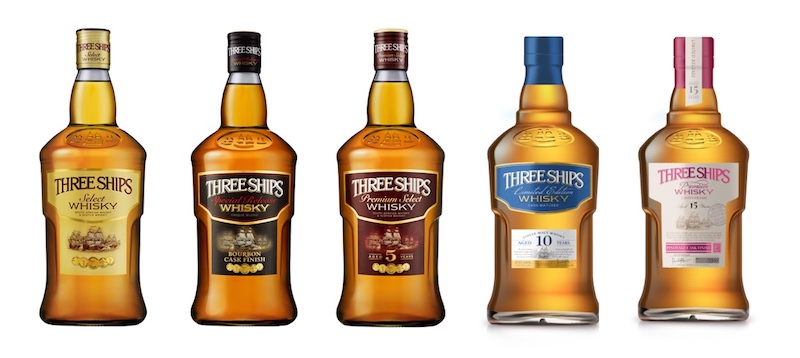
Three Ships has a range of five different whiskies. One of them is a single malt, while the others are blended. Almost all of them have won awards in various international whiskies competition.
The Three Ship Select Whisky is launched in 1977 and has served the whisky community in the past 40 years. It is a blend of malt and grain whiskies. The high quality blended whisky has won the hearts of many whisky drinkers with its taste profile. It is an excellent dram for both whisky lovers and casual drinkers.
JSD launched Three Ships Bourbon Cask Finish in 2005. It holds the title as the first 100% South African blended whisky as the distillery made both the malt and grain whiskies on the home ground. JSD also matured the whisky within its warehouses. The Three Ships Bourbon Cask Finish is a great catch for the ladies, with its vanilla sweetness and honeyed notes.
The Three Ships 5-Year-Old is another blended whisky made by JSD and launched in 1991. This malt used in this blend contains heavily peated malted barley. When the malt and grain are mixed to form the 5-year-old whisky, the peatiness of the malt reduced into a pleasant smoke. It is also well-received among ladies.
The Three Ships 10-Year-Old is launched in 2015 after maturing the liquid for ten years. Distilled in 2005, this is the first single malt whisky to carry a vintage statement. Made from peated barley, this whisky is slightly smokier when compared to the 5-year-old blend.
The Three Ship 15-year-old Pinotage Cask Finish is the first whisky in the world (and of course South Africa) to finish in a Pinotage cask. The Pinotage is a distinctive South African wine created in 1925 by Abraham Izak Perold. This whisky is also the oldest whisky released by Three Ships to date, crafted by their #6 Master Distiller, Andy Watts. This rich and complex whisky reflects the unique heritage of South Africa.
The Bain’s Cape Mountain Whisky shares its home with Three Ships in the JSD. The single grain whisky pays homage to the man, Andrew Geddes Bain, who built the Bainkloof Pass to connect Wellington to the interior of the country in 1853. The whisky is distilled from corn (yellow maize) and double matured in two batches of first-filled bourbon casks.
JSD continues to be a pioneer in South African whisky and contributes significantly to the world of whisky. Andy Watts is now the head of the entire Distell whisky portfolio, which includes single malts – Bunnahabhain, Deanston & Tobermory – as well as blends – Black Bottle and Scottish Leader. Jeff Green is replacing Andy Watts as the master distiller at JSD after shadowing Andy for the past six years. His efforts to learn has paid off, and we look forward to more great whiskies from JSD!
11311 Harry Hines Blvd
Dallas, TX, United States
(555) 389 976
dallas@enfold-restaurant.com
